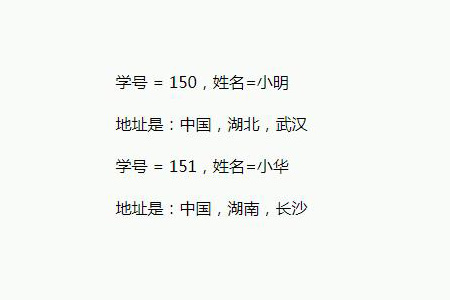What is aggregation in java
Aggregation in Java is a special form of association. It is the relationship between two classes. It is a HAS-A relationship and a one-way association. If a class has entity references, it is called an aggregation.

For example: There are two classes Studentclass and Addressclass, which represent students and addresses respectively. The Studentclass class contains a lot of information, such as: studentId, studentName, etc., and also contains an Addressclass class. The Addressclass class has its own information, such as country, provincial capital, city, etc. As shown below:
class Address
{
String country;
String province;
String city;
.....
}
class StudentClass
{
int studentId;
String studentName;
//创建与Addressclass类的HAS-A关系
Address studentAddr;
StudentClass(int id, String name, Address addr){
......
}
}In this case, the Studentclass class has an entity reference to the Addressclass class; and
Each student has a specific address, so the relationship between students and addresses is A Has-A relationship, that is: Student Has-A Address
Why use aggregation?
Because it can maintain the reusability of code.
For example, based on the two classes Student and Address in the above example, two other classes College and Staff are used, which represent colleges and staff.
To have addresses for students, college addresses, and staff, now, we don't need to use the same code again and again; we just need to reference the Address class when defining each class.
Therefore, we can improve the reusability of code by using aggregation relationships.
Aggregation example
class Address {
String country,province,city;
public Address(String country, String province, String city) {
this.country = country;
this.province = province;
this.city = city;
}
}
public class StudentClass{
int id;
String name;
Address address;
public StudentClass(int id, String name,Address address) {
this.id = id;
this.name = name;
this.address=address;
}
void display(){
System.out.println("="+id+",name="+name);
System.out.println("地址是: "+address.country+","+address.province+","+address.city+"\n");
}
public static void main(String[] args) {
Address address1=new Address("China","Hubei","Wuhan");
Address address2=new Address("China","Hunan","Changsha");
StudentClass Student1=new StudentClass(150,"小明",address1);
StudentClassStudent2=new StudentClass(151,"小华",address2);
Student1.display();
Student2.display();
}
}Rendering:

Summary: The above is this The entire content of this article, I hope it will be helpful to everyone's study.
The above is the detailed content of What is aggregation in java. For more information, please follow other related articles on the PHP Chinese website!

Hot AI Tools

Undresser.AI Undress
AI-powered app for creating realistic nude photos

AI Clothes Remover
Online AI tool for removing clothes from photos.

Undress AI Tool
Undress images for free

Clothoff.io
AI clothes remover

AI Hentai Generator
Generate AI Hentai for free.

Hot Article

Hot Tools

Notepad++7.3.1
Easy-to-use and free code editor

SublimeText3 Chinese version
Chinese version, very easy to use

Zend Studio 13.0.1
Powerful PHP integrated development environment

Dreamweaver CS6
Visual web development tools

SublimeText3 Mac version
God-level code editing software (SublimeText3)

Hot Topics
 Square Root in Java
Aug 30, 2024 pm 04:26 PM
Square Root in Java
Aug 30, 2024 pm 04:26 PM
Guide to Square Root in Java. Here we discuss how Square Root works in Java with example and its code implementation respectively.
 Perfect Number in Java
Aug 30, 2024 pm 04:28 PM
Perfect Number in Java
Aug 30, 2024 pm 04:28 PM
Guide to Perfect Number in Java. Here we discuss the Definition, How to check Perfect number in Java?, examples with code implementation.
 Random Number Generator in Java
Aug 30, 2024 pm 04:27 PM
Random Number Generator in Java
Aug 30, 2024 pm 04:27 PM
Guide to Random Number Generator in Java. Here we discuss Functions in Java with examples and two different Generators with ther examples.
 Weka in Java
Aug 30, 2024 pm 04:28 PM
Weka in Java
Aug 30, 2024 pm 04:28 PM
Guide to Weka in Java. Here we discuss the Introduction, how to use weka java, the type of platform, and advantages with examples.
 Armstrong Number in Java
Aug 30, 2024 pm 04:26 PM
Armstrong Number in Java
Aug 30, 2024 pm 04:26 PM
Guide to the Armstrong Number in Java. Here we discuss an introduction to Armstrong's number in java along with some of the code.
 Smith Number in Java
Aug 30, 2024 pm 04:28 PM
Smith Number in Java
Aug 30, 2024 pm 04:28 PM
Guide to Smith Number in Java. Here we discuss the Definition, How to check smith number in Java? example with code implementation.
 Java Spring Interview Questions
Aug 30, 2024 pm 04:29 PM
Java Spring Interview Questions
Aug 30, 2024 pm 04:29 PM
In this article, we have kept the most asked Java Spring Interview Questions with their detailed answers. So that you can crack the interview.
 Break or return from Java 8 stream forEach?
Feb 07, 2025 pm 12:09 PM
Break or return from Java 8 stream forEach?
Feb 07, 2025 pm 12:09 PM
Java 8 introduces the Stream API, providing a powerful and expressive way to process data collections. However, a common question when using Stream is: How to break or return from a forEach operation? Traditional loops allow for early interruption or return, but Stream's forEach method does not directly support this method. This article will explain the reasons and explore alternative methods for implementing premature termination in Stream processing systems. Further reading: Java Stream API improvements Understand Stream forEach The forEach method is a terminal operation that performs one operation on each element in the Stream. Its design intention is






